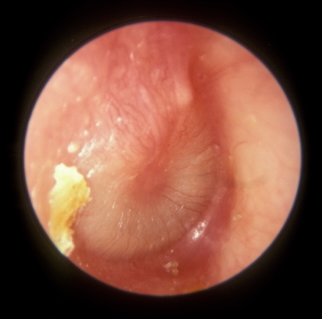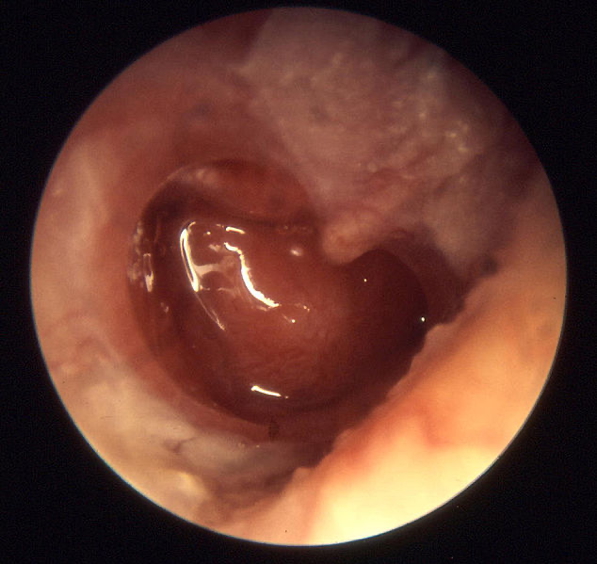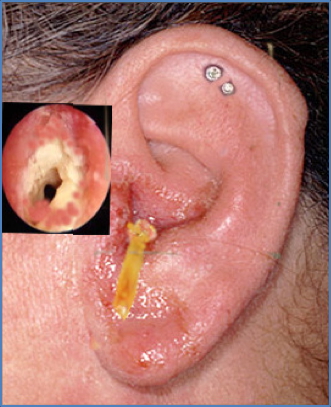Table of Contents
Overview – Ear Infections
Ear infections are among the most common causes of otalgia (ear pain) and otorrhoea (ear discharge). They are broadly classified based on the location of inflammation: otitis externa (external ear), acute otitis media (middle ear), and chronic otitis media. Accurate diagnosis is essential, especially in paediatrics, to prevent hearing loss, developmental delays, and serious complications such as mastoiditis or intracranial spread.
Acute Otitis Media
Definition
Acute inflammation and infection of the middle ear, typically following an upper respiratory tract infection (URTI).
Aetiology
- Bacterial invasion via the Eustachian tube following URTI.
- Common pathogens: Streptococcus pneumoniae, Haemophilus influenzae, Moraxella catarrhalis.
Clinical Features
- Earache, irritability, ear-pulling (especially in children)
- Fever, cough, rhinorrhoea
- Conductive hearing loss
- Otoscopic signs:
- Bulging, erythematous tympanic membrane
- Fluid/pus behind drum
- Decreased mobility of the tympanic membrane
Complications
- Tympanic membrane rupture → otorrhoea
- Mastoiditis
- Facial nerve palsy (rare)
- Hearing loss
Management
- Analgesia (paracetamol, ibuprofen)
- Antibiotics if:
- <2yrs bilateral AOM
- Otorrhoea present
- Systemically unwell
- Watchful waiting in mild, uncomplicated cases
- Follow-up for resolution or persistent symptoms


Chronic Otitis Media
Definition
Long-standing or recurrent middle ear infection resulting in tympanic membrane damage and potential ossicular or bony erosion.
Aetiology
- Eustachian tube dysfunction
- Early-life nasopharyngeal colonisation
- Recurrent acute otitis media
Clinical Features
- Chronic ear discharge (otorrhoea)
- Hearing loss
- Developmental delay or poor school performance
- Otoscopy:
- Tympanic membrane retraction or perforation
- Presence of cholesteatoma
- Scarring and ossicular damage
Complications
- Cholesteatoma
- Ossicular erosion
- Hearing loss
- Intracranial spread
Management
- Aural toilet (microsuction)
- Topical and/or oral antibiotics
- Grommet insertion to ventilate middle ear
- Surgery for cholesteatoma (e.g. mastoidectomy)


Otitis Externa
Definition
Infection or inflammation of the external auditory canal, also known as “swimmer’s ear.
Aetiology
- Bacterial or fungal infection secondary to:
- Water exposure (swimming, humidity)
- Canal trauma (cotton buds, hearing aids)
Clinical Features
- Pain (especially on manipulation of pinna)
- Itchiness
- Ear discharge
- Swollen, erythematous canal
- Occasional fever or cellulitis
Management
- Topical antibiotic/steroid ear drops (e.g. ciprofloxacin + hydrocortisone)
- Aural cleaning (if required)
- Avoid swimming/moisture during recovery
- Oral antibiotics for cellulitis


Otorrhoea (Ear Discharge)
Causes
- Acute otitis media with perforation
- Chronic otitis media
- Otitis externa
- Cholesteatoma
- Foreign body
Evaluation
- Otoscopy to identify source
- Swab for MCS if chronic or resistant
- Consider imaging if cholesteatoma suspected


Ear Examination & History
History
- Recurrent infections
- Hearing loss
- Diabetes (risk factor for malignant otitis externa)
- Neurological symptoms (e.g. facial palsy)
- Ototoxic medications
- Noise exposure
Examination
- External inspection: deformities, discharge, tenderness
- Palpation: tragus and pinna tenderness (suggests otitis externa)
- Otoscopy: Tympanic membrane appearance, colour, mobility
- Tuning Fork Tests: Weber, Rinne
- Balance Tests: Romberg, Dix-Hallpike
- Audiometry/Tympanometry: Specialist referral if indicated
Summary – Ear Infections
Ear infections encompass a spectrum of conditions including acute otitis media, chronic otitis media, and otitis externa, each with distinct causes, presentations, and complications. Thorough otoscopy, targeted management, and awareness of red flags like cholesteatoma are essential for optimal care. For more ENT and neuro-related topics, see our Nervous System Overview.